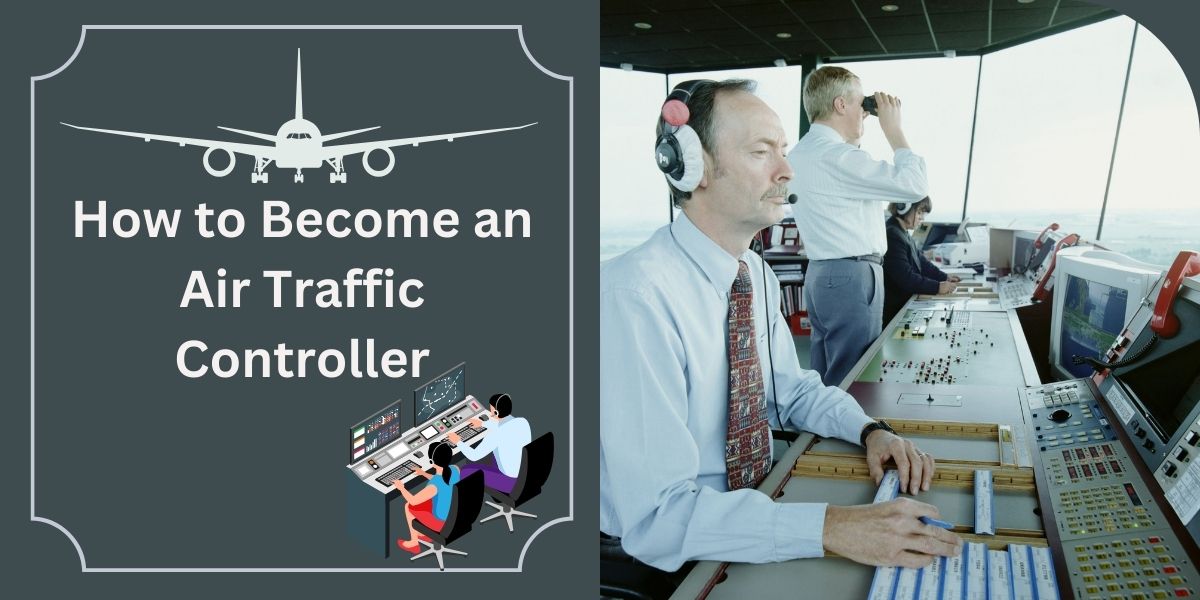Embarking on the journey to become an air traffic controller is a rewarding aviation career. There are necessary educational requirements you need to meet that will equip you with the fundamental knowledge needed to navigate the complex world of air traffic management.
Air traffic controllers keep passengers safe by ensuring planes and other aircraft navigate the skies at a safe distance from each other. They also help reduce delays at airports and airfields by directing traffic and finding alternative pathways for incoming and outgoing aircraft.
In this article, we will discuss how to become an air traffic controller, their duties, types, and salary, together with the pros and cons.
Who is an air traffic controller?
An air traffic controller is a skilled professional responsible for managing the safe and efficient movement of aircraft within controlled airspace and on the ground at airports.
An air traffic controller is responsible for coordinating the movement of air traffic, guiding pilots during takeoff and landing, and monitoring the planes as they travel through the skies. They manage communication by transferring control of departing flights to traffic control centers, and they accept control of arriving flights.
Controllers typically work in airport traffic control towers, air route-traffic control centers, terminal radar approach control facilities, or the National Airspace System (NAS). They provide services to aircraft traveling in domestic airspace and nationally controlled international oceanic airspace.
What does an air traffic controller do?
The primary role of an aircraft controller is to prevent collisions between aircraft and ensure a smooth flow of air traffic. This involves providing clear and concise instructions to pilots, coordinating takeoffs and landings, and managing aircraft during their en-route phase.
Here is a list of their responsibilities:
- Communicate with pilots and other personnel about flight plans, flight paths, takeoffs, and landings
- Monitor incoming and outgoing flights and flightpaths to ensure all aircraft fly at a safe distance from each other
- Find alternative pathways for flights to reduce traffic and airport delays
- Communicate with pilots about delays, closures, severe weather, or any other information that could impact flight plans
- Direct ground traffic on airport taxiways, runways, and hangars
How to Become an Air Traffic Controller
Follow these steps to become an air traffic controller:
1. Pursue an education
While not an absolute requirement, aspiring air traffic controllers can typically benefit from an associate’s or bachelor’s degree from an Air Traffic Collegiate Training Initiative (AT-CTI) program.
Candidates with a bachelor’s degree, three years of progressively responsible work experience, or a combination of the two may also be considered.
However, because these jobs tend to be highly competitive, a two- or four-year degree from an AT-CTI school will prepare you for a career in air traffic control and earn you priority consideration.
The classes that candidates take in these programs are focused on subjects fundamental to aviation.
Students study airspace, aviation, weather, reading charts, federal regulations, clearances, and other similar topics. 36 schools across the country are approved through AT-CTI to offer associate, bachelor’s, and master’s degree programs for aspiring air traffic controllers.
2. Meet the Federal Aviation Administration requirements
To become an air traffic controller, you must meet the following requirements:
- Be a U.S. citizen.
- Pass a medical evaluation and drug screening.
- Pass a background check.
- Complete a training course at the FAA Academy before turning 31.
- Get a passing score on the FAA air traffic pre-employment test
- Be able to speak English clearly
- Be able to relocate to an FAA facility
3. Pass the qualifying tests for an FAA training program
After completing the AT-CTI program, students who have a recommendation letter from their school are eligible to take the Air Traffic Selection and Training exam.
Students usually take this exam before graduation, but they must have met their school’s requirements to receive the recommendation.
They are also required to pass the FAA pre-employment test, which assesses personality and fitness. After passing the exams, they are eligible to apply for air traffic controller jobs. Once they have accepted a job offer, graduates are eligible to enroll in the training course at FAA Academy.
Candidates who have not completed the AT-CTI program can also apply during one of the FAA’s enrollment periods, but hiring teams often give preference to AT-CTI program graduates and veterans with aviation experience.
Entry-level civilian candidates must also pass the pre-employment test to be considered for the FAA Academy training.
4. Complete an FAA training program
After qualifying for the training program, it’s necessary to complete it at the FAA Academy. Training at FAA Academy is located in Oklahoma City, Oklahoma. It usually lasts from two to five months, depending on your background and the position for which you’ve been hired.
5. Gain experience
After graduating from the FAA Academy, trainees are assigned to an air traffic control facility as developmental controllers. In this role, they supply pilots with basic airport and flight information. As they obtain more experience, they advance to positions in the control role that offer greater responsibility.
6. Obtain a certification
Air traffic controllers must be certified by the FAA. You can earn certification by passing a knowledge test and practical exam and meeting the experience requirements through on-the-job training. It typically takes two to four years to complete the training which leads to full certification.
Skills to Become an Air Traffic Controller
Air traffic controllers develop specialized skills through years of training and experience. Here are some of the skills commonly associated with a career in air traffic control:
- Active listening: Air traffic controllers listen attentively to ensure the proper organization of aircraft taking off, landing, and cruising. They also diligently respond to any messages that they receive from flight crews.
- Communication: Effective communication skills are another key element to being a successful air traffic controller. Communicating clearly and effectively with flight crews and other control towers is necessary for maintaining airline safety and avoiding emergencies.
- Critical thinking: It’s common for air traffic controllers to be in situations that require fast and efficient decision-making. Effective critical thinking skills are important for air traffic controllers to perform their potentially life-saving duties.
- Concentration: Because they maintain the flow of aircraft in and out of airports and in-flight, air traffic controllers are key to aviation safety. Doing this successfully requires total concentration.
- Decision-making skills: Air traffic controllers must be able to make quick decisions that impact the safety of everyone onboard an aircraft.
- Math skills: Controllers must be able to calculate speed, time, and distance and recommend changes in heading or altitude.
Types of Air Traffic Controllers
The two primary types of air traffic controllers are:
- Tower controllers: Controller teams in towers monitor all aircraft in terminal airspace. They help to maintain the flow of traffic into and out of the airport, ensure safe distances between aircraft, and update pilots on important weather information.
- En route controllers: En route controllers use surveillance equipment to maintain safe distances between aircraft. They also provide traffic information and weather advisories to aircraft under their control as the pilots navigate the airspace between airports.
How much does an air traffic controller make?
The national average salary for an air traffic controller is $57,197 per year, with salaries ranging from $14,000 to $130,000 depending on the location of the facility, complexity of the flight path, and other factors. Typically, salaries increase according to the level of training the air traffic controller completes
Work Schedule of an Air Traffic Controller
Most air traffic controllers work full-time, although some may work additional hours. However, the FAA regulates the number of hours that an air traffic controller may work.
They may not work more than 10 hours straight or have less than nine hours between shifts. Air traffic controllers might work nights, weekends, or on a rotation if they work for larger facilities with ongoing operating times.
Projected Job Growth
With modern air travel becoming more affordable, the number of planes in the skies has increased. This is expected to increase demand for air traffic controllers over the coming decade.
Pros of Being an Air Traffic Controller
Here are some of the pros of pursuing a career as an air traffic controller:
1. Work indoors
One benefit of working as an air traffic controller is that you complete all of your duties indoors. Air traffic controllers typically work inside to account for different weather patterns.
Control towers are built with strong materials that can withstand severe conditions, like hurricanes and earthquakes, and feature other commodities such as air conditioning.
2. Financial stability
Air traffic controllers may experience financial stability due to the salary of the job. The average salary of an air traffic controller is $57,197 per year, although more experience can contribute to higher pay.
Depending on where they work, air traffic controllers could also get other cost-saving perks, such as on-site child care and transportation subsidies.
3. A crucial part of the air travel system
Air traffic controllers are responsible for the lives of everyone aboard the aircraft. Their guidance and expertise help make flying a safe and convenient form of travel.
Air traffic controllers ensure people can fly from destination to destination and are a vital element of the travel and transportation industry.
4. Frequent breaks and leisure time
Another benefit of working in air traffic control is the breaks during shifts. Being well-rested and alert is a huge component of succeeding as an air traffic controller.
Employees are often given frequent breaks throughout their shifts where they can rest. They also enjoy leisure time off in between shifts before getting back to the control room.
5. Low physical labor
Another pro of the job is its little-to-no physical labor expectations. Air traffic controllers are typically seated for a majority, if not the entirety, of their shifts to stay focused and manage their responsibilities. Air traffic controllers may experience good physical health due to the lack of strain on their bodies.
6. Early retirement
One more common perk of working as an air traffic controller is the ability to retire at an early age. In many states, air traffic controllers work between 20 and 30 years before becoming eligible for retirement.
This leaves more time for employees to pursue their other passions and interests post-retirement.
Cons of Being an Air Traffic Controller
Here are some of the cons of working as an air traffic controller that you might consider:
1. High-pressure work environment
Air traffic control can be an extremely high-pressure job. Every day, air traffic controllers are directly responsible for thousands of lives and play a key role in keeping flights on schedule.
Protecting the lives of passengers and crew is extremely important when conducting air traffic control, which may take a mental toll on employees.
In many cases, cross-training employees can help manage this. Cross-training is when employees are trained in several aspects of the job, meaning they can take over different roles at any point.
This way, the most stressful assignments can be divided and rotated among the controllers so they can have moments to rest and recover while working a shift.
2. Working weekends and holidays
Holidays and weekends are the busiest times to fly, which means air traffic controllers are often required to work during these periods.
By implementing cross-training, schedulers can alternate employees for these shifts. This way, air traffic controllers can still spend time with their families during these times.
3. Night shifts
It’s common for air traffic controllers to work night shifts, as planes still take off and land well into the evening. Because being alert and awake is an important part of the job, it’s helpful to get a quality amount of sleep before every shift.
Cross-training can give management the ability to schedule more people because everyone is qualified for all work roles. This way, employees do not have to work entire night shifts and can maintain a more regular sleeping schedule.
4. There is little room for growth
Air traffic control is a highly specialized and thoroughly trained job. Those who pass the steps necessary to become an air traffic controller often lack the skills necessary for other jobs in the corporate world, which may make it difficult to switch careers.
Cross-training can result in a broader training curriculum for employees that covers various elements of the air travel industry. This way, air traffic controllers can have a more diverse skill set and qualify for other jobs outside of air traffic control.
Conclusion
Embarking on the path to becoming an air traffic controller is a journey filled with learning, challenges, and the thrill of guiding planes through the skies.
If you’re interested in starting a career that provides a high salary without requiring a four-year degree, you may consider becoming an air traffic controller. However, if you want to get hired in this aviation career, take note of the pros and cons associated with it.




 Jobi.ng
Jobi.ng




